This EduRev document offers 10 Multiple Choice Questions (MCQs) from the topic Cubes & Dices (Level - 2). These questions are of Level - 2 difficulty and will assist you in the preparation of CAT & other MBA exams. You can practice/attempt these CAT Multiple Choice Questions (MCQs) and check the explanations for a better understanding of the topic.
Question for Practice Questions Level 2: Cubes & Dices
Try yourself:A cube is painted orange on two adjacent faces, white on two adjacent faces and green on the remaining faces. Now the cube is cut into 125 smaller cubes of equal size.
How many cubes are there with at least 1 green face?
Explanation
There are 5 × 5 = 25 cubes on one face.
Now, there will be an edge comprising 5 cubes which shall be common to both the faces coloured green.
Thus, the number of cubes with at least one face green = (25 × 2) - 5 = 50 - 5 = 45.
Thus, answer option 4 is correct.
Report a problem
Question for Practice Questions Level 2: Cubes & Dices
Try yourself:A cube is painted orange on two adjacent faces, white on two adjacent faces and green on the remaining faces. Now the cube is cut into 125 smaller cubes of equal size.
How many cubes are there with their faces coloured only white, if at all?
Explanation
The diagrammatic representation of the same is as shown.
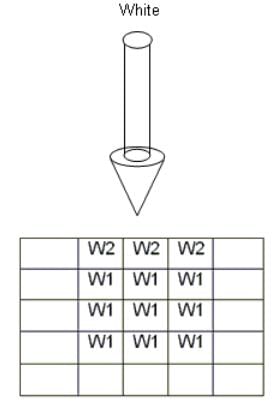
On the face, as shown in the figure, there are 9 cubes marked W1 with only one face coloured white. Similarly, there will be 9 cubes with only one face, each coloured white.
Now, on the edge common to both the faces coloured white, there shall be 3 cubes with two faces each coloured white as represented by W2.
Thus, total number of cubes = 9 × 2 + 3 = 18 + 3 = 21.
Hence, answer option 3 is correct.
Report a problem
Question for Practice Questions Level 2: Cubes & Dices
Try yourself:Directions: A cube is painted orange on two adjacent faces, white on two adjacent faces and green on the remaining faces. Now the cube is cut into 125 smaller cubes of equal size.
How many cubes are there with only one face coloured orange?
Explanation
The diagrammatic representation of an orange face is as shown, with the adjacent faces marked as shown.
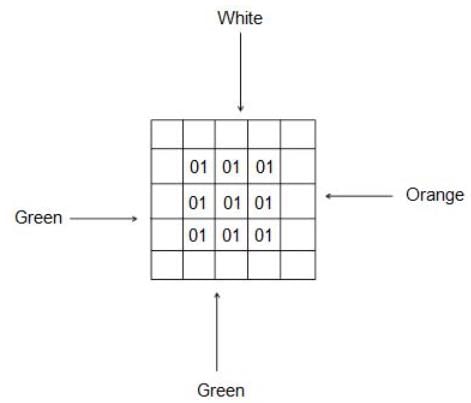
The face with a face coloured orange with small cubes marked as O1 will be the small cubes with only one face coloured orange.
There are 9 such cubes. There shall be 9 such cubes on the adjacent face as well.
Thus, there shall be 18 cubes like this in all.
Hence, answer option 3 is correct.
Report a problem
Question for Practice Questions Level 2: Cubes & Dices
Try yourself:Directions: Read the following information and answer the question given below.
A cube of side 10 cm is coloured red, with a 2 cm wide green strip along all the sides on all the faces. The cube is cut into 125 smaller cubes of equal sizes.
Q. How many cubes have three green faces each?
Explanation
Clearly, upon colouring the cube as stated and then cutting it into 125 smaller cubes of equal sizes, we get a stack of cubes as shown in the figure.
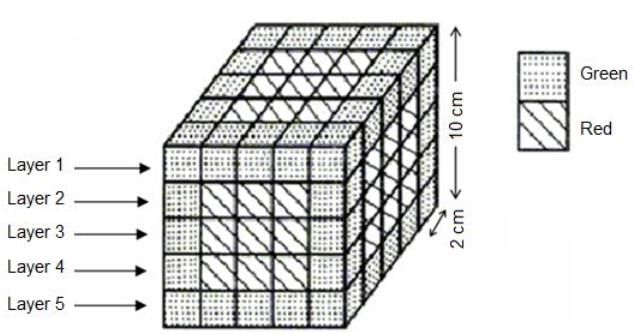
The figure can be analysed by assuming the stack to be composed of 5 horizontal layers.
There are 4 corner cubes in layer 1, and 4 corner cubes in layer 5, having three green faces each.
Thus, there are 8 such cubes.
Report a problem
Question for Practice Questions Level 2: Cubes & Dices
Try yourself:Directions: Read the following information and answer the question given below.
A cube of side 10 cm is coloured red, with a 2 cm wide green strip along all the sides on all the faces. The cube is cut into 125 smaller cubes of equal sizes.
Q. How many cubes are without any colour?
Explanation
There are 9 central cubes in each of the layers 2, 3 and 4, which are without any colour.

Thus, there are 9 × 3 = 27 such cubes.
Report a problem
Question for Practice Questions Level 2: Cubes & Dices
Try yourself:The shape in the figure given below is folded to form a box. Choose from the alternatives (1), (2), (3) and (4), the boxes that are similar to the box formed from the shape below.
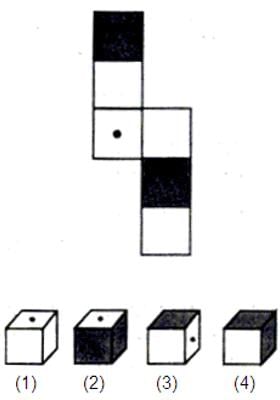
Explanation
The dot will lie opposite to one of the shaded surfaces.
Therefore, figure (2) cannot be formed.
Report a problem
Question for Practice Questions Level 2: Cubes & Dices
Try yourself:Two positions of a dice are given. Which of the following numbers would be at the top when 2 is at the bottom?
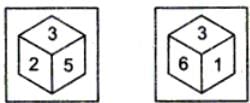
Explanation
Number 3 appears in the same position both times.
The pattern of numbers is as given below.
From first orientation, write the numbers in clockwise direction.
3 - 5 - 2
From second orientation, write the numbers in clockwise direction.
3 - 1 - 6
Hence, 2 is opposite to number 6 and 5 is opposite to number 1.
Report a problem
Question for Practice Questions Level 2: Cubes & Dices
Try yourself:Which of the following cubes can be created by folding the given figure?

Explanation
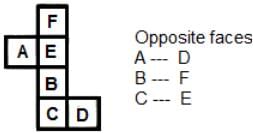
Opposite faces cannot come adjacent to each other.
Hence, answer figure (b) can be created by folding the given figure.
Report a problem
Question for Practice Questions Level 2: Cubes & Dices
Try yourself:Directions: In the following question, four positions of the same dice having different characters are shown.

Explanation
Four characters will be adjacent to each character.
As shown, *, ?, # and $ are adjacent to character +.
So, the only character that will be opposite to '+' is '@'.
Report a problem
Question for Practice Questions Level 2: Cubes & Dices
Try yourself:Directions: Figure (A) below shows an unfolded cubical dice. This unfolded figure is followed by four different figures of dice. You have to select the figure which is identical to figure (A).

Explanation
As per figure (A), we get that @ is opposite to *, % is opposite to # and $ is opposite to =. The characters which are in the adjacent faces cannot be opposite to each other.
From this, it is clear that only figure (c) is possible.
So, option (3) is the correct answer.
Report a problem

























